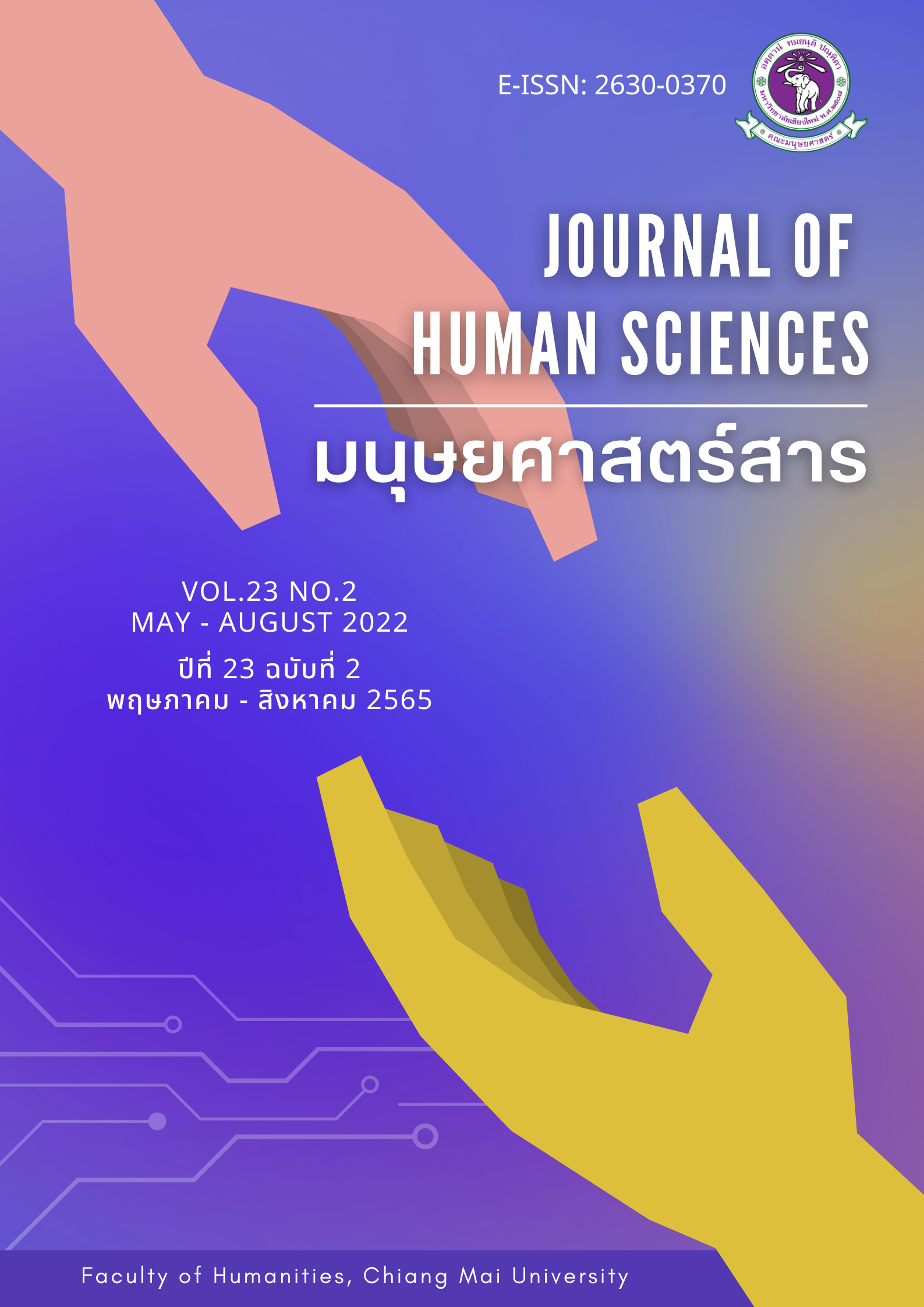จากสาวเครือฟ้า สู่กาสะลอง ซ้องปีบ และส้มป่อย: การสร้างภาพผู้หญิงล้านนาภายใต้แนวคิดเรื่องเพศทวิลักษณ์และปิตาธิปไตยแบบตะวันตก
Main Article Content
บทคัดย่อ
ภาพของผู้หญิงล้านนาถูกสร้างผ่านมุมมองของสยามและปรากฏในสื่อต่าง ๆ ในลักษณะของหญิงสาวเรียบร้อย อ่อนหวาน ใสซื่อ ซึ่งเป็นภาพที่ถูกผลิตเพื่อจุดประสงค์ทางการท่องเที่ยวและถูกผลิตซ้ำผ่านวรรณกรรมและสื่อร่วมสมัยอย่างเช่นภาพยนตร์และละครโทรทัศน์จนกลายเป็นภาพจำ ภาพลักษณ์ดังกล่าวได้รับอิทธิพลจากแนวคิดเรื่องเพศแบบทวิลักษณ์ที่รับมาจากตะวันตก ในขณะที่แนวคิดเรื่องเพศในสังคมล้านนายุคจารีตไม่ได้มีความเป็นทวิลักษณ์หรือปิตาธิปไตยที่เข้มข้น บทความนี้เปรียบเทียบแนวคิดเรื่องเพศในสังคมไทยและล้านนาในสมัยยุคจารีต และภายหลังการเข้ามาของแนวคิดเรื่องเพศวิถีแบบตะวันตก โดยยกตัวอย่างการสร้างภาพลักษณ์ในละครโทรทัศน์และภาพยนตร์ไทย ด้วยการชี้ให้เห็นว่าภาพลักษณ์ผู้หญิงล้านนาติดอยู่ในกรอบของแนวคิดเพศทวิลักษณ์และปิตาธิปไตย อย่างไรก็ตามตัวละครในยุคหลังเริ่มเป็นการนำเสนอภาพลักษณ์ผู้หญิงล้านนาในมิติอื่นมากขึ้นและสะท้อนแนวคิดเรื่องเพศในสังคมล้านนาที่ยอมรับบทบาท อิสรภาพ และอำนาจของผู้หญิง
Article Details

อนุญาตภายใต้เงื่อนไข Creative Commons Attribution-NonCommercial-NoDerivatives 4.0 International License.
เอกสารอ้างอิง
ณรงค์กรรณ รอดทรัพย์. (2555). ปิตาธิปไตย: ภาพสะท้อนแห่งความไม่เสมอภาคระหว่างชายหญิงในสังคมเอเชีย. วารสารวิชาการ มหาวิทยาลัยราชภัฏบุรีรัมย์, 4(2), 30-46.
ดารุณี สมศรี. (2549). การสร้างภาพลักษณ์ความงามของเมืองเชียงใหม่ พ.ศ.2464-2500. (วิทยานิพนธ์ปริญญามหาบัณฑิต). จุฬาลงกรณ์มหาวิทยาลัย, กรุงเทพ.
ทัศนีย์ สาลีโภชน์. (2564). ลาบดิบ ร่างทรง สงกรานต์เมือง สัญญะที่ซ่อนในหนัง ‘ส้มป่อย’. สืบค้นเมื่อวันที่ 8 มกราคม 2565, จาก https://www.bangkokbiznews.com/lifestyle/970054
เทิดศักดิ์ ร่มจำปา. (2546). จาก “กะเทย” ถึง “เกย์” ประวัติศาสตร์ชายรักร่วมเพศในสังคมไทย. วารสารอักษรศาสตร์, 32(1), 303-332.
นุมาน หะยีมะแซ. (2560). บูรพาคดีในภูมิภาคมลายู: ศึกษาพัฒนาการบูรพาคดีอังกฤษในคาบสมุทรมลายู ค.ศ. 1786-1957. วารสารวิชาการคณะมนุษยศาสตร์และสังคมศาสตร์, 13(2), 9-48.
ปิยะนาถ อังควาณิชกุล และคณะ. (2560). การศึกษาสถานภาพและวิถีชีวิตสตรีไทยภาคเหนือจากงานบันทึกผ่านจิตรกรรมล้านนา. วารสารสถาบันวัฒนธรรมและศิลปะ, 19(1), 82-91.
ปิยะมาศ ใจไฝ่. (2560). แนวคิดอทวิลักษณ์ของสตรีนิยมเชิงนิเวศในล้านนา. วารสารปณิธาน. 13(2), 212-227.
ภักดีกุล รัตนา. (2543). ภาพลักษณ์ “ผู้หญิงเหนือ” ตั้งแต่ปลายพุทธศตวรรษที่ 25 ถึงต้นพุทธศตวรรษที่ 26. (วิทยานิพนธ์ปริญญามหาบัณฑิต). มหาวิทยาลัยเชียงใหม่, เชียงใหม่.
ภักดีกุล รัตนา. (2562). ผู้หญิงล้านนากับการศึกษา. วารสารข่วงผญา, 14, 111-143.
ภักดีกุล รัตนา. (2565). การขัดเกลาทางสังคมต่อคุณลักษณะของผู้หญิงในบริบทของล้านนา. วารสารสังคมศาสตร์และมนุษยศาสตร์, 48(1), 67-84.
ภิญญพันธุ์ พจนะลาวัณย์. (2564). ส้มป่อย: การตบตีกันของสาวเครือฟ้าและอีลำยองเวอร์ชั่นล้านนา เรื่องเล่าบนความเหลื่อมล้ำของพื้นที่เมืองและชนบท. สืบค้นเมื่อวันที่ 25 ธันวาคม 2564. จากhttps://filmclubthailand.com/film-review/sompoi/?fbclid=IwAR27-YRfe3Vx83eb3emz-5idmswurDsRPyADgO_b_5zpXujL0Wm4FeSPD8M
มุกริน วิโรจน์ชูฉัตร. (2538). มาดามบัตเตอร์ฟลาย : ศึกษาเปรียบเทียบฉบับต่าง ๆ และอิทธิพลที่มีต่อวรรณกรรมไทย. (วิทยานิพนธ์ปริญญามหาบัณฑิต). จุฬาลงกรณ์มหาวิทยาลัย, กรุงเทพ.
สรัสวดี อ๋องสกุล. (2562). บทบาทของขัตติยนารีในประวัติศาสตร์ล้านนา. วารสารประวัติศาสตร์ 2562, 14-31.
สุระ อินตามูล. (2555). พิธีกรรมทรงผีเจ้านาย: พื้นที่เปิดทางเพศภาวะในสังคมล้านนา. รายงานการวิจัย ศูนย์มานุษยวิทยาสิรินธร.
อรธีรา. (2564). สัมภาษณ์ 2 ผู้กำกับหน้าใหม่จากเรื่อง ‘ส้มป่อย’ หนังไทยที่ฉีกกฎสาวเหนือผู้อ่อนหวาน. สืบค้นเมื่อวันที่ 1 มกราคม 2565, จาก https://workpointtoday.com/sompai/
Chiang Mai News. (2562). “ลาบดิบ” ของกินคนเมือง. สืบค้นเมื่อวันที่ 1 มกราคม 2565, จากhttps://www.chiangmainews.co.th/page/archives/893566/
Gypzy World. (2560). ควายไม่มีโรคคือลาบอันประเสริฐ วัฒนธรรมลาบกับความเชื่อเรื่องโชคลาภของคนเหนือและอีสาน. สืบค้นเมื่อวันที่ 1 มกราคม 2565, จาก https://www.gypzyworld.com/article/view/675
Hasan, M.M. (2005). The orientalization of gender. American Journal of Islamic Social Sciences. 22(4), 26-56.
Jackson, P.A. and Sullivan, G. (1999). A Ponoply of Roles. Journal of Gay & Lesbian Social Services, 9(2-3), 1-27.
Jackson, P.A. (2001). Pre-Gay, Post-Queer. Journal of Homosexuality, 40(3-4), 1-25.
Loos, T. (2005). Sex in the Inner City: The Fidelity between Sex and Politics in Siam. The Journal of Asian Studies, 64(4), 881-909.
Mendus, S. and Rendall, J. (1989). Sexuality and Subordination: Interdisciplinary studies of gender in the nineteenth century. London and New York: Routledge.
Moonsarn, K. (2020). Combi-nation: Thai nation building and national identity in Thai TV dramas with Northern Thai focus. (Doctoral’s thesis, University of Leeds, Leeds).
Reynolds, C.J. (2006). Seditious Histories: Contesting Thai and Southeast Asia pasts. London: University of Washington Press.
Rose, S.O. (1992). Limited Livelihoods: Gender and class in nineteenth-century England. London: Routledge.
Said, E.W. (1979). Oriantalism. New York: Vintage Books, Random House.
Shabanirad, E. and Marandi, S.M. (2015). Edward Said’s orientalism and the Representation of oriental Women in George orwell’s Burmese Days. International Letters of Social and Humanistic Sciences. 60, 22-33.
Sinnott, M. J. (2004). Toms and Dees: transgender identity and female same-sex relationships in Thailand. Honolulu: University of Hawaii Press.
Tannenbaum, N. (1999). Buddhism, prostitution, and sex: limits on the academic discourse on gender in Thailand. In P.A. Jackson and N.M. Cooks (eds.), Genders and Sexualities in modern Thailand (pp. 243-260). Chiang Mai: Silkworm Books.
Tosh, J. (2005). Manliness and Masculinities in Nineteenth-century Britain. London: Pearson Longman.
Trumbach, R. (1993). London’s Sapphists: From Three Sexes to Four Genders in the Making of Modern Culture. In Herdt, G. (ed.), Third Sex, Third Gender: Beyond Sexual Dimorphism in Culture and History (pp. 111-136). New York: Zone Books.
Woodhouse, L.A. (2009). A “Foreign” Princess in the Siamese Court: Princess Dara Rasami, the Politics of Gender and Ethnic Difference in Nineteenth-Century Siam (Doctoral’s thesis, University of California, Berkeley).


